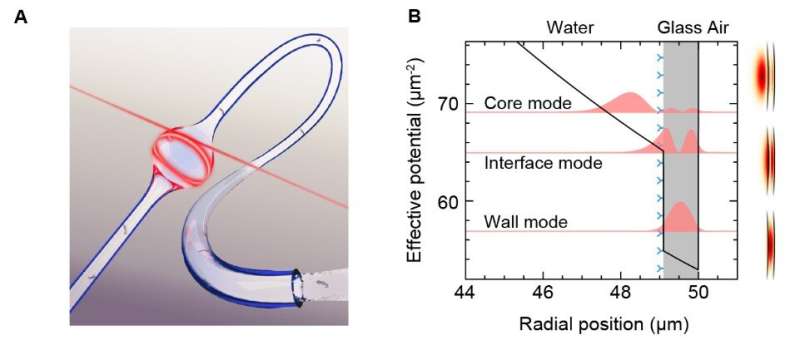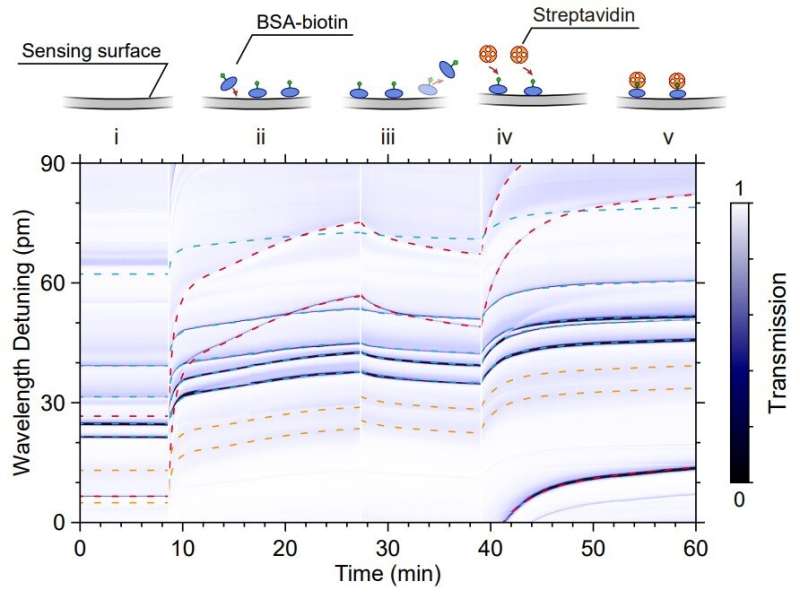Single-molecule optofluidic microsensor with interface whispering gallery modes

Optical evanescent microsensors have attracted considerable research interests since they can detect unlabelled molecules and monitor their interactions in real time and in situ with ultrahigh sensitivity, fast response, and miniature footprint. However, these sensors utilize the weak tail of evanescence field rather than the peak of the electromagnetic field on the sensing surface, limiting their sensitivities. Very recently, scientists from Professor Xiao Yun-Feng's group at Peking University, collaborating with Dr. Chen You-Ling at Institute of Semiconductors, CAS, have proposed the interface whispering gallery mode (WGM) with the electromagnetic field peaked at the sensing surface of a microbubble cavity, and demonstrated the detection of single DNA molecules with the molecular weight of 8 kDa. This work has been published online in PNAS.
Over the past few years, the microbubble resonator has been widely used for sensing applications such as measuring refractive index, biomolecule concentration and single nanoparticles. Generally, the optical resonance modes are localized in the liquid core or silica wall. In this work, the researchers find that, the profile of the WGM field can be tuned by varying the wall thickness, and interface mode emerges when the maximum of the field intensity is drawn onto the inner surface of the microbubble resonator (Fig. 1). In practice, the interface modes exhibit distinctive thermal responses to temperature disturbance comparing with the modes localized in the liquid core or the bubble wall, according to which they can be identified from the mode family.
"The trade-off between the evanescent field magnitude and the quality factor has been a long-lasting bottle-neck for evanescent sensors. Microbubble cavities utilize the inner interface as the sensing surface, and the interface modes can maximize the electromagnetic field intensity at the sensing surface while still maintaining a high-quality factor," said Dr. Yu Xiao-Chong, the co-first author of this work.

Experimentally, the sensing capabilities of the optofluidic microsensor are characterized by detecting streptavidin proteins using microbubble resonator pre-functionalized with biotinylated bovine serum albumin (BSA-biotin) molecules (Fig. 2). As BSA-biotin molecules gradually enter the microfluidic channel, all WGMs experience red shifts (Fig. 2B-ii) due to the molecular adsorption onto the hydroxylated silica surface. After removing the surplus BSA-biotin molecules with citrate buffer rinsing (Fig. 2B-iii), streptavidin proteins are then delivered into the microbubble cavity. Further red shifts occur due to specific binding between the two kinds of molecules (Fig. 2B-iv).
"The interface mode shows an at-least 2-fold sensitivity improvement compared with both the wall and core modes," said Dr. Tang Shui-Jing, the co-first author of this work and a Boya postdoctoral researcher at Peking University.
The interface mode provides a way to physically improve the sensitivity of evanescent sensors, and it is compatible with the widely adopted signal-to-noise-ratio enhancement techniques. For example, with the plasmonic-enhanced interface mode, detection of a single-strand DNA molecule was demonstrated.
"Intrinsically integrated into a microfluidic system, this sensor exhibits ultra-small sample consumption, providing an automatic and highly efficient platform for biomedical analysis and early-stage diagnostics." said Prof. Xiao
More information: Xiao-Chong Yu et al, Single-molecule optofluidic microsensor with interface whispering gallery modes, Proceedings of the National Academy of Sciences (2022). DOI: 10.1073/pnas.2108678119
Journal information: Proceedings of the National Academy of Sciences
Provided by Peking University




















